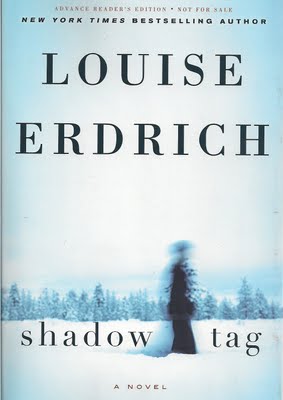Review of Shadow Tag by Louise Erdrich
Reviewed by Cher'ley Grogg
 Shadow Tag, written in narrative form allows the author, Louise Erdrich, to move seamlessly between characters. The novel revolves around a single family. The father Gil America, his wife Irene and their three children; 14 year old son Forian, 11 year old daughter, Riel and 6 year old son Stoney. The family is American Indian and their heritage plays a vital role in the story.
Shadow Tag, written in narrative form allows the author, Louise Erdrich, to move seamlessly between characters. The novel revolves around a single family. The father Gil America, his wife Irene and their three children; 14 year old son Forian, 11 year old daughter, Riel and 6 year old son Stoney. The family is American Indian and their heritage plays a vital role in the story.
Gil is an artist who has become famous by painting a series called "Irene America". Irene and Gil met when as a young maiden she started modeling for him--they fell in love and married. His personal intimate relationship with his wife allowed him the freedom to paint her from virginal girl to sensual woman. Gil painted her in every pose imaginable, pregnant, on all fours, with the impression rape, dismemberment, death by smallpox, and in ways that only he knows what they represent.
Irene hangs on to the elusion of becoming an art historian and has an office in their basement to do work on her studies. In a bottom drawer, covered with ribbons and wrapping paper, in the very back of a file cabinet is her Red Diary. She begins to suspect that her husband is reading her diary. Once she confirms this, she uses it to manipulate him. She still has the need to write out her feelings so she buys a safe-deposit box where she keeps her true diary, the Blue Notebook.
Gil has invaded her privacy and everyday she grows more resentful; everyday she drinks more wine. The marriage goes from rocky to turbulent.
The two older children affected by their parents' stormy relationship cross boundaries that kids their age should not be crossing. The youngest, a budding artist draws many pictures of his family. His mother asks him about the "stick with a little half-moon" that he always paints at the end of her hand. With the simplicity of a first grader he answers, "the wineglass".
A few happy times appear in the novel and one evening, during one of those times Gil and Irene ran outside with their three children to play a Native American game called shadow tag. If you step on a person's shadow, you capture them. Irene felt Gil had captured her and that she had no way out.
Shadow Tag starts out as a slow read; the scenes feel stretched out a little too far. The explicit scenes and language do little to increase the pace. As the book progresses there is redemption because interest grows for the characters.
This book explores human relationships and the intricacies of a broken family. It feels as if the author has had first hand experiences with these issues.
 Shadow Tag, written in narrative form allows the author, Louise Erdrich, to move seamlessly between characters. The novel revolves around a single family. The father Gil America, his wife Irene and their three children; 14 year old son Forian, 11 year old daughter, Riel and 6 year old son Stoney. The family is American Indian and their heritage plays a vital role in the story.
Shadow Tag, written in narrative form allows the author, Louise Erdrich, to move seamlessly between characters. The novel revolves around a single family. The father Gil America, his wife Irene and their three children; 14 year old son Forian, 11 year old daughter, Riel and 6 year old son Stoney. The family is American Indian and their heritage plays a vital role in the story.Gil is an artist who has become famous by painting a series called "Irene America". Irene and Gil met when as a young maiden she started modeling for him--they fell in love and married. His personal intimate relationship with his wife allowed him the freedom to paint her from virginal girl to sensual woman. Gil painted her in every pose imaginable, pregnant, on all fours, with the impression rape, dismemberment, death by smallpox, and in ways that only he knows what they represent.
Irene hangs on to the elusion of becoming an art historian and has an office in their basement to do work on her studies. In a bottom drawer, covered with ribbons and wrapping paper, in the very back of a file cabinet is her Red Diary. She begins to suspect that her husband is reading her diary. Once she confirms this, she uses it to manipulate him. She still has the need to write out her feelings so she buys a safe-deposit box where she keeps her true diary, the Blue Notebook.
Gil has invaded her privacy and everyday she grows more resentful; everyday she drinks more wine. The marriage goes from rocky to turbulent.
The two older children affected by their parents' stormy relationship cross boundaries that kids their age should not be crossing. The youngest, a budding artist draws many pictures of his family. His mother asks him about the "stick with a little half-moon" that he always paints at the end of her hand. With the simplicity of a first grader he answers, "the wineglass".
A few happy times appear in the novel and one evening, during one of those times Gil and Irene ran outside with their three children to play a Native American game called shadow tag. If you step on a person's shadow, you capture them. Irene felt Gil had captured her and that she had no way out.
Shadow Tag starts out as a slow read; the scenes feel stretched out a little too far. The explicit scenes and language do little to increase the pace. As the book progresses there is redemption because interest grows for the characters.
This book explores human relationships and the intricacies of a broken family. It feels as if the author has had first hand experiences with these issues.
Labels: diary, Erdrich, family relationships, Louise, Native-American, novel, Shadow-tag, wine











